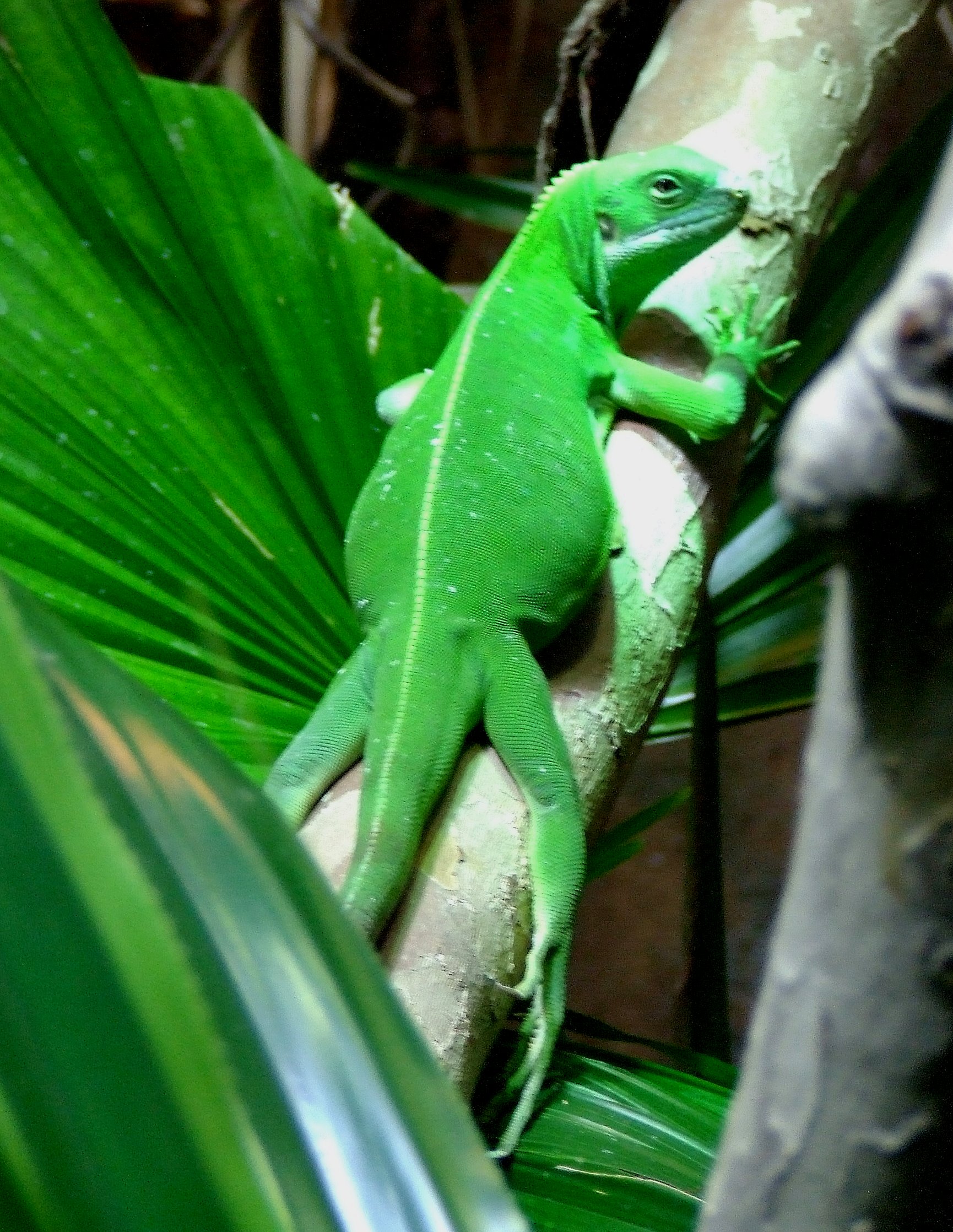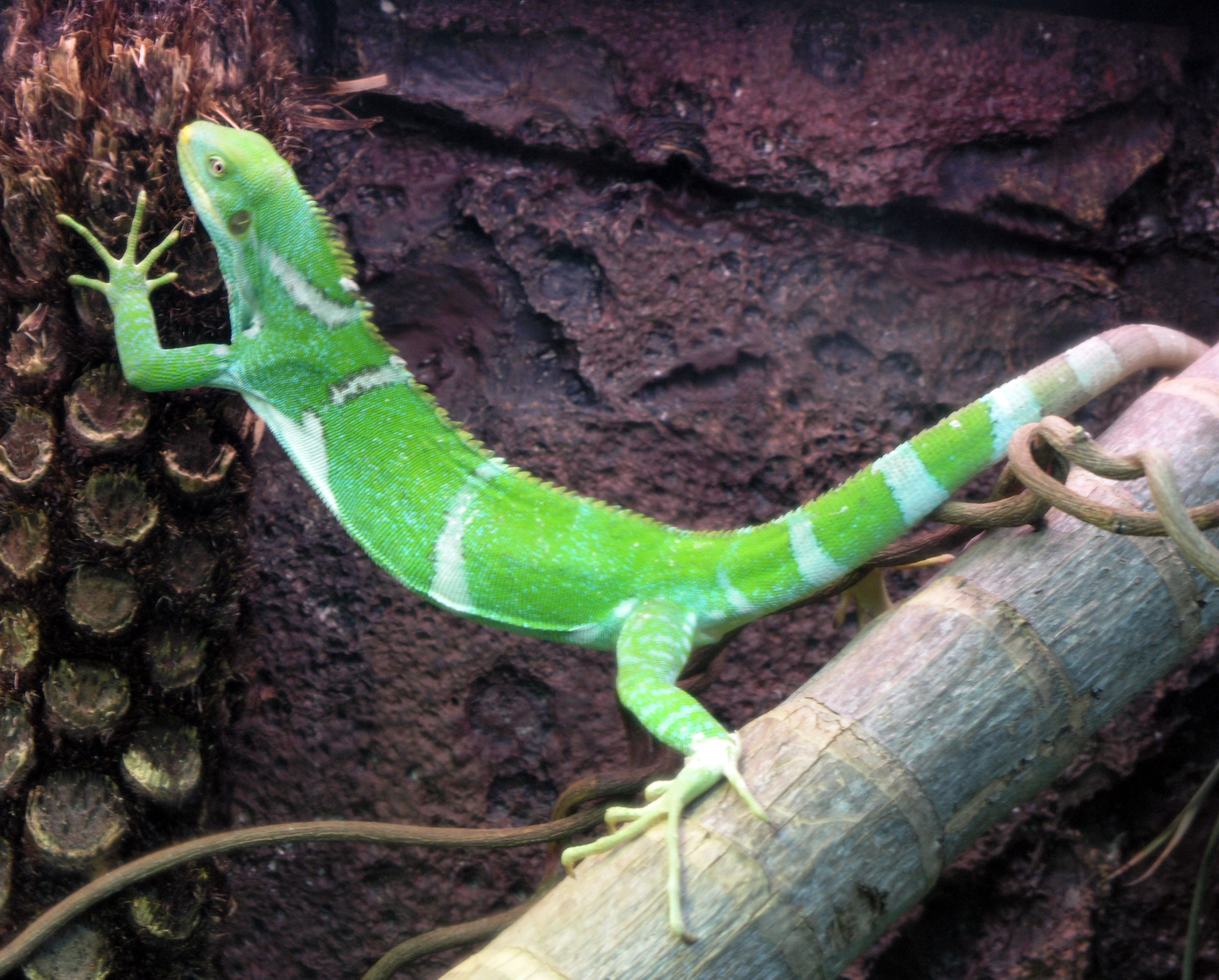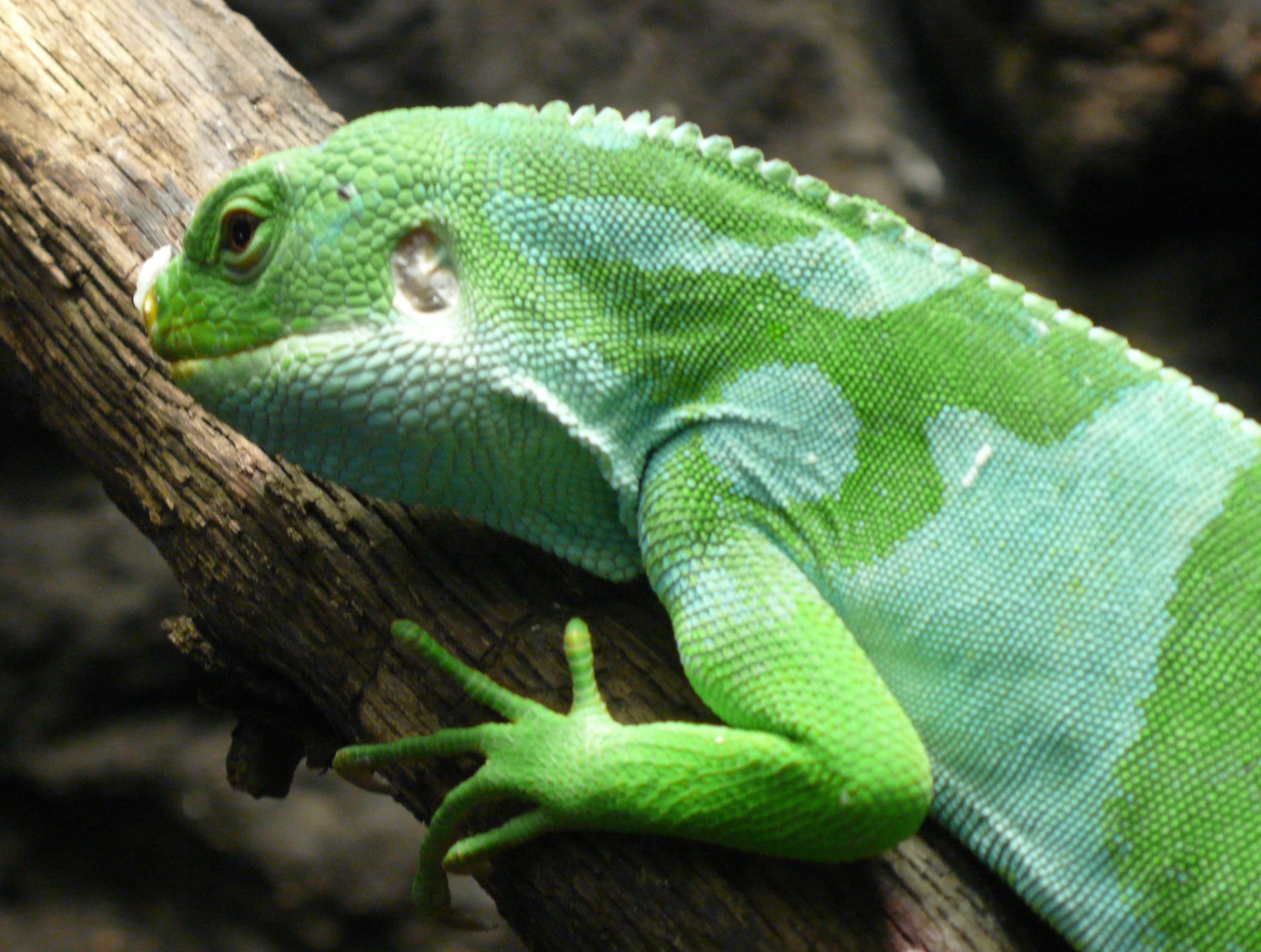|
Brachylophus
The genus ''Brachylophus'' consists of four extant iguanid species native to the islands of Fiji and a giant extinct species from Tonga in the South West Pacific. One of the extant species, ''B. fasciatus'', is also present on Tonga, where it has apparently been introduced by humans. Etymology and taxonomy The name, ''Brachylophus'', is derived from two Greek words: brachys (βραχύς) meaning "short" and lophos (λόφος) meaning "crest" or "plume", denoting the short spiny crests found along the backs of these species. ''Brachylophus'' species are the most geographically isolated iguanas in the world. Their closest extant relatives (the genera ''Amblyrhynchus'', ''Conolophus'', ''Ctenosaura'', ''Cyclura'', ''Iguana'' and '' Sauromalus'') are present in primarily tropical regions of the Americas and islands in the Galápagos and Lesser and Greater Antilles. Several of these genera are adapted to xeric biomes. Phylogenetic evidence supports the ''Brachylophus'' lineage to ... [...More Info...] [...Related Items...] OR: [Wikipedia] [Google] [Baidu] |
Brachylophus Vitiensis
The Fiji crested iguana or Fijian crested iguana (''Brachylophus vitiensis'') is a critically endangered species of iguana native to some of the northwestern islands of the Fijiian archipelago, where it is found in dry forest on Yaduataba (west of Vanua Levu), Yadua, Macuata, Yaquaga, Devuilau (Goat island), Malolo, Monu and Monuriki. Discovery The discovery of ''B. vitiensis'' resulted from herpetologist Dr. John Gibbons of the University of the South Pacific being invited to a screening of the movie '' The Blue Lagoon''. Part of the movie was filmed on a remote island in Fiji and shots of the native wildlife, including a large colorful iguanid, were included. Gibbons, who was studying the Fiji banded iguana at the time, traveled to the island and identified the lizard in the film as a distinct species new to science. Taxonomy and etymology The generic name, ''Brachylophus'', is derived from two Greek words: brachys (βραχῦς) meaning "short" and lophos (λοφος) mean ... [...More Info...] [...Related Items...] OR: [Wikipedia] [Google] [Baidu] |
Brachylophus Fasciatus
''Brachylophus fasciatus'', the Lau banded iguana, is an arboreal species of lizard endemic to the Lau Islands of the eastern part of the Fijian archipelago. It is also found in Tonga, where it was probably introduced by humans. It is one of the few species of iguanas found outside of the New World and one of the most geographically isolated members of the family Iguanidae. Populations of these iguanas have been declining over the past century due to habitat destruction, and more significantly, the introduction of mongoose and house cats to the islands. The species is diurnal, spending their days foraging, basking and watching over their territories by day and retreating to the treetops at night. Fiji iguanas are considered a national treasure by the government of Fiji, and its likeness has been featured on postage stamps, currency, and phone book covers. Taxonomy and etymology This species was first described by French zoologist Alexandre Brongniart in 1800. Brongniart,Alexand ... [...More Info...] [...Related Items...] OR: [Wikipedia] [Google] [Baidu] |
Fiji Banded Iguana
''Brachylophus bulabula'', commonly known as the Central Fijian Banded Iguana is a species of iguanid lizard endemic to some of the larger central and northwestern islands of Fiji ( Ovalau, Kadavu and Viti Levu), where it occurs in Fijian wet forest. It was described by a team led by a scientist from the Australian National University in 2008. It is one of the few species of iguana found outside of the New World and one of the most geographically isolated members of the family Iguanidae. Initially also reported from Gau Island, in 2017 this population was described as a separate species, '' B. gau''. They can grow up to 2 feet long and have an average lifespan of 10-15 years. However, there have been some captive Fiji banded iguanas that have lived as long as 25 years. Fijian banded iguana typically are found in tropical wet islands that are typically 650-1700 feet above sea level. They also like to bask in temperatures ranging from . The areas that are most suitable for Fiji b ... [...More Info...] [...Related Items...] OR: [Wikipedia] [Google] [Baidu] |
Brachylophus Bulabula
''Brachylophus bulabula'', commonly known as the Central Fijian Banded Iguana is a species of Iguanidae, iguanid lizard endemic to some of the larger central and northwestern islands of Fiji (Ovalau (Fiji), Ovalau, Kadavu Island, Kadavu and Viti Levu), where it occurs in Fijian Tropical rainforest, wet forest. It was described by a team led by a scientist from the Australian National University in 2008. It is one of the few species of Iguanidae, iguana found outside of the New World and one of the most geographically isolated members of the family Iguanidae. Initially also reported from Gau Island, in 2017 this population was described as a separate species, ''Brachylophus gau, B. gau''. They can grow up to 2 feet long and have an average lifespan of 10-15 years. However, there have been some captive Fiji banded iguanas that have lived as long as 25 years. Fijian banded iguana typically are found in tropical wet islands that are typically 650-1700 feet above sea level. They also li ... [...More Info...] [...Related Items...] OR: [Wikipedia] [Google] [Baidu] |
Iguanid
The Iguanidae is a family of lizards composed of the iguanas, chuckwallas, and their prehistoric relatives, including the widespread green iguana. Taxonomy Iguanidae is thought to be the sister group to the collared lizards (family Crotaphytidae); the two groups likely diverged during the Late Cretaceous, as that is when ''Pristiguana'' and ''Pariguana'', the two earliest fossil genera, are known from. The subfamily Iguaninae, which contains all modern genera, likely originated in the earliest Paleocene, at about 62 million years ago. The most basal extant genus, '' Dipsosaurus,'' diverged from the rest of Iguaninae during the late Eocene, about 38 million years ago, with ''Brachylophus'' following a few million years later at about 35 million years ago, presumably after its dispersal event to the Pacific. All other modern iguana genera formed in the Neogene period. A phylogenetic tree of Iguaninae is shown here: Description Iguanas and iguana-type species are diverse i ... [...More Info...] [...Related Items...] OR: [Wikipedia] [Google] [Baidu] |
Brachylophus Gibbonsi
''Brachylophus gibbonsi'' is an extinct species of large (~1.2 m long) iguanid lizard from Tonga in the South Pacific Ocean. Its remains have been found associated with cultural sites on Lifuka, four other islands in the Haʻapai group, and Tongatapu. It was consumed by the early Tongans and probably became extinct within a century of human colonization of the archipelago 2800 years ago. The four extant members of ''Brachylophus'' are much smaller, and are found in nearby Fiji. '' B. fasciatus'' is now present on Tonga as well, but was probably brought there from Fiji by humans about 800 years ago. ''B. gibbonsi'' is estimated to have been about 1.8 times the length of its living relatives. An even larger Fijian iguana of the genus '' Lapitiguana'' was also formerly present, and also became extinct shortly after the arrival of humans. The genus ''Brachylophus'' is thought to have reached the South Pacific by rafting on the South Equatorial Current 9000 km westward from the ... [...More Info...] [...Related Items...] OR: [Wikipedia] [Google] [Baidu] |
Brachylophus Gau
The Gau iguana (''Brachylophus gau'') is a species of iguana endemic to Gau Island in the Fijian archipelago. It mostly lives in the well-preserved upland forests of the island, with smaller populations in the degraded coastal forests. It can be distinguished from other South Pacific iguanas by the male's distinctive color pattern and solid green throat. It is also the smallest of all South Pacific iguanas, being about 13% smaller than the third smallest species and 40% smaller than the largest extant species. The species was first recorded on Gau Island by the Scottish naturalist John MacGillivray in 1854, during his travels on . However, it did not receive a proper species description until 2017. It is considered endangered on the IUCN Red List due to the presence of invasive mammalian predators on its island, such as black rats (''Rattus rattus''), Polynesian rats (''Rattus exulans''), feral cats (''Felis catus''), and free-ranging goats (''Capra hircus''). Forests are frequen ... [...More Info...] [...Related Items...] OR: [Wikipedia] [Google] [Baidu] |
Basal (phylogenetics)
In phylogenetics, basal is the direction of the ''base'' (or root) of a phylogenetic tree#Rooted tree, rooted phylogenetic tree or cladogram. The term may be more strictly applied only to nodes adjacent to the root, or more loosely applied to nodes regarded as being close to the root. Note that extant taxa that lie on branches connecting directly to the root are not more closely related to the root than any other extant taxa. While there must always be two or more equally "basal" clades sprouting from the root of every cladogram, those clades may differ widely in taxonomic rank, Phylogenetic diversity, species diversity, or both. If ''C'' is a basal clade within ''D'' that has the lowest rank of all basal clades within ''D'', ''C'' may be described as ''the'' basal taxon of that rank within ''D''. The concept of a 'key innovation' implies some degree of correlation between evolutionary innovation and cladogenesis, diversification. However, such a correlation does not make a given ca ... [...More Info...] [...Related Items...] OR: [Wikipedia] [Google] [Baidu] |
Lesser Antilles
The Lesser Antilles ( es, link=no, Antillas Menores; french: link=no, Petites Antilles; pap, Antias Menor; nl, Kleine Antillen) are a group of islands in the Caribbean Sea. Most of them are part of a long, partially volcanic island arc between the Greater Antilles to the north-west and the continent of South America."West Indies." ''Merriam-Webster's Geographical Dictionary'', 3rd ed. 2001. () Springfield, MA: Merriam-Webster Inc., p. 1298. The islands of the Lesser Antilles form the eastern boundary of the Caribbean Sea where it meets the Atlantic Ocean. Together, the Lesser Antilles and the Greater Antilles make up the Antilles. (Somewhat confusingly, the word Caribbean is sometimes used to refer only to the Antilles, and sometimes used to refer to a much larger region.) The Lesser and Greater Antilles, together with the Lucayan Archipelago, are collectively known as the West Indies. History after European arrival The Spanish were the first Europeans to arrive on the ... [...More Info...] [...Related Items...] OR: [Wikipedia] [Google] [Baidu] |
Tropics
The tropics are the regions of Earth surrounding the Equator. They are defined in latitude by the Tropic of Cancer in the Northern Hemisphere at N and the Tropic of Capricorn in the Southern Hemisphere at S. The tropics are also referred to as the tropical zone and the torrid zone (see geographical zone). In terms of climate, the tropics receive sunlight that is more direct than the rest of Earth and are generally hotter and wetter as they aren't affected as much by the solar seasons. The word "tropical" sometimes refers to this sort of climate in the zone rather than to the geographical zone itself. The tropical zone includes deserts and snow-capped mountains, which are not tropical in the climatic sense. The tropics are distinguished from the other climatic and biomatic regions of Earth, which are the middle latitudes and the polar regions on either side of the equatorial zone. The tropics constitute 40% of Earth's surface area and contain 36% of Earth's landmass. , the ... [...More Info...] [...Related Items...] OR: [Wikipedia] [Google] [Baidu] |
Americas
The Americas, which are sometimes collectively called America, are a landmass comprising the totality of North and South America. The Americas make up most of the land in Earth's Western Hemisphere and comprise the New World. Along with their associated islands, the Americas cover 8% of Earth's total surface area and 28.4% of its land area. The topography is dominated by the American Cordillera, a long chain of mountains that runs the length of the west coast. The flatter eastern side of the Americas is dominated by large river basins, such as the Amazon, St. Lawrence River–Great Lakes basin, Mississippi, and La Plata. Since the Americas extend from north to south, the climate and ecology vary widely, from the arctic tundra of Northern Canada, Greenland, and Alaska, to the tropical rain forests in Central America and South America. Humans first settled the Americas from Asia between 42,000 and 17,000 years ago. A second migration of Na-Dene speakers followed later ... [...More Info...] [...Related Items...] OR: [Wikipedia] [Google] [Baidu] |
Galápagos Islands
The Galápagos Islands (Spanish: , , ) are an archipelago of volcanic islands. They are distributed on each side of the equator in the Pacific Ocean, surrounding the centre of the Western Hemisphere, and are part of the Republic of Ecuador. Located west of continental Ecuador, the islands are known for their large number of endemic species that were studied by Charles Darwin during the second voyage of HMS ''Beagle''. His observations and collections contributed to the inception of Darwin's theory of evolution by means of natural selection. The Galápagos Islands and their surrounding waters form the Galápagos Province of Ecuador, the Galápagos National Park, and the Galápagos Marine Reserve. The principal language on the islands is Spanish. The islands have a population of slightly over 25,000. The first recorded visit to the islands happened by chance in 1535, when Fray Tomás de Berlanga, the Bishop of Panamá, was surprised to find this undiscovered land on a vo ... [...More Info...] [...Related Items...] OR: [Wikipedia] [Google] [Baidu] |





.jpg)
